By Tommy Clarkson from the February 2016 Edition
Cape Plumbago, Plumbago auriculata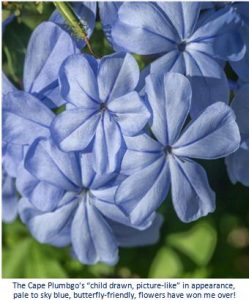
Family: Plumbaginaceae
Also known as: Cape Leadwort, Skyflower or Blue Plumbago
Generally decisive, it took me several years to finally decide whether or not I liked this old fashioned sprawling, suckering, and fast growing landscape bush. I should, as they’ve long been found in gardens pretty much all around the world. Ultimately, however, its somewhat basic “child drawn picture-like” in appearance, pale to sky blue, butterfly-friendly, flowers won me over!
Ranging throughout the tropics and subtropics, there are ten to twenty-four (depends on which authority one chooses to believe) different species in the Plumbago genus. Some authorities say that its genus name originated from the Greek word meaning “lead” as the plants were once thought to be a cure for lead poisoning. Yet others cite that its other name, Leadwort, was derived from folks’ use of it as a home remedy for infections which caused the skin of the person who’d ingested it to take on a leaden hue. (So, who are ya’ gonna’ believe?)
Beyond that, the Plumbago was traditionally used to treat warts, broken bones and wounds. It was also taken as a snuff for headaches and an emetic to dispel bad dreams. If that all was not cause enough to want them in your garden, a stick of the plant was once placed in the thatch of one’s hut to ward off lightning!
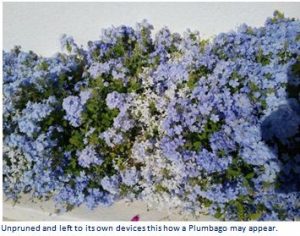 Plumbago auriculata was once known to many as Plumbago capensis – the name given it by the botanist, Thunberg in 1794. However, come to find out, it had already been named P.auriculata in 1786, in the East Indies, where it was rather commonly known and grown as a garden plant. Appreciated for those rather delicate, pale blue flowers,
Plumbago auriculata was once known to many as Plumbago capensis – the name given it by the botanist, Thunberg in 1794. However, come to find out, it had already been named P.auriculata in 1786, in the East Indies, where it was rather commonly known and grown as a garden plant. Appreciated for those rather delicate, pale blue flowers,
the Cape Plumbago is, appropriately enough, originally from the Cape Province of South Africa. There is now a darker, cobalt blue form, “Royal Cape”, which might be available in your local nursery or vivero. Beyond these,via botanical labs, there is now one white cultivar P. auriculata, variant Alba.
While there are some medical uses for parts of the Plumbago auriculata, one should be advised that it is moderately poisonous if eaten.
Having the ability to reach more than a couple of meters (over six feet) in height, this woody climbing shrub is more commonly seen as a low hedge or border plant as it does best if regularly pruned – even, occasionally, cut all the way back to the ground.
It can be cut back to grow like a vine and made to scramble over supports, carefully pruned into a compact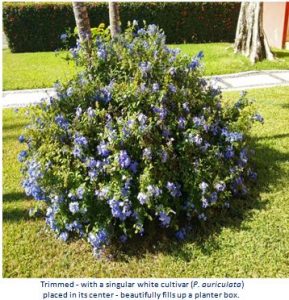 mounded shrub or left to sprawl, as it wishes, with its long, rather gracefully arching branches. It can also be incorporated along walls, placed as foundation plantings or massed in beds. Some use Cape Plumbago as a background or filler plant used under and in front of larger shrubs.
mounded shrub or left to sprawl, as it wishes, with its long, rather gracefully arching branches. It can also be incorporated along walls, placed as foundation plantings or massed in beds. Some use Cape Plumbago as a background or filler plant used under and in front of larger shrubs.
It will bloom, for the most part, throughout the year, preferring the warmer months, thriving in humid environs.
It is important to keep in mind that the most prolific blooming of one’s Cape Plumbago will be directly related to its periodic pruning and placement in bright sunlight.
Its many, five-ribbed, flowers are borne on terminal spikes. Its fruit consists of a small nut that is enclosed within its calyx (the outer whorl of a flower which encloses the corolla, stamens and female portion of the flower). Its leaves are oblanceolate to spathulate (like a reversed lance head, rounded in appearance, somewhat in a spoon shape). The new growth is a bright green but becomes darker when age. (I just get greyer and more wrinkled!)
The foliage can turn yellowish as a result of manganese deficiency, but the application of manganese sulfate can cure this problem. In simpler, more innocent times, children often made
“earrings” with the sticky flowers by letting them cling to their earlobes. This was naturally made easy by the tacky, gland tipped hairs on the flower calyx. The Cape Plumbago seed capsule maintains that stickiness which probably helps disperse the seeds by attaching to passing animals, where after the capsule splits opens the seeds drop out.
While it can tolerate drought and poor soil, if given its preference it would choose slightly higher altitudes in which to grow. It also would like ample sun and for a healthier looking specimen, grow in fertile, welldraining, properly composted soil. Do not allow it to dry out.
It can be propagated from seeds, cuttings or simple division of older plants.
For back issues of “Roots”, gardening tips, tropical plant book reviews and videos of numerous, highly unique eco/ adventure/ nature tours, as well as memorable “Ultimate Experiences” such as Tropical Garden Brunches
Visit us at.. www.olabrisagardens.com
Download the full edition or view it online
—
Tommy Clarkson is a bit of a renaissance man. He’s lived and worked in locales as disparate as the 1.2 square mile island of Kwajalein to war-torn Iraq, from aboard he and Patty’s boat berthed out of Sea Bright, NJ to Thailand, Germany, Hawaii and Viet Nam; He’s taught classes and courses on creative writing and mass communications from the elementary grades to graduate level; He’s spoken to a wide array of meetings, conferences and assemblages on topics as varied as Buddhism, strategic marketing and tropical plants; In the latter category he and Patty’s recently book, “The Civilized Jungle” – written for the lay gardener – has been heralded as “the best tropical plant book in the last ten years”; And, according to Trip Advisor, their spectacular tropical creation – Ola Brisa Gardens – is the “Number One Tour destination in Manzanillo”.



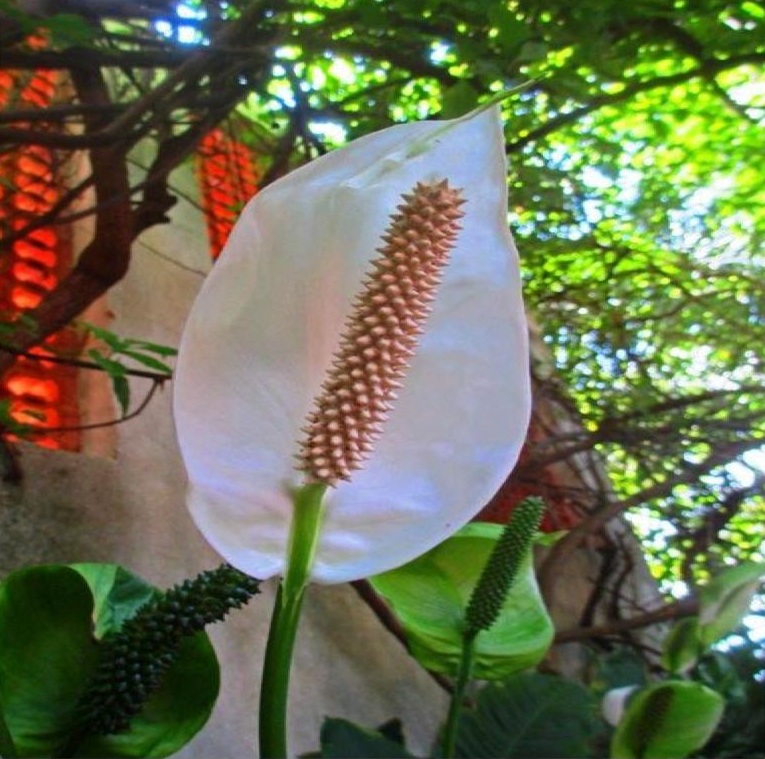
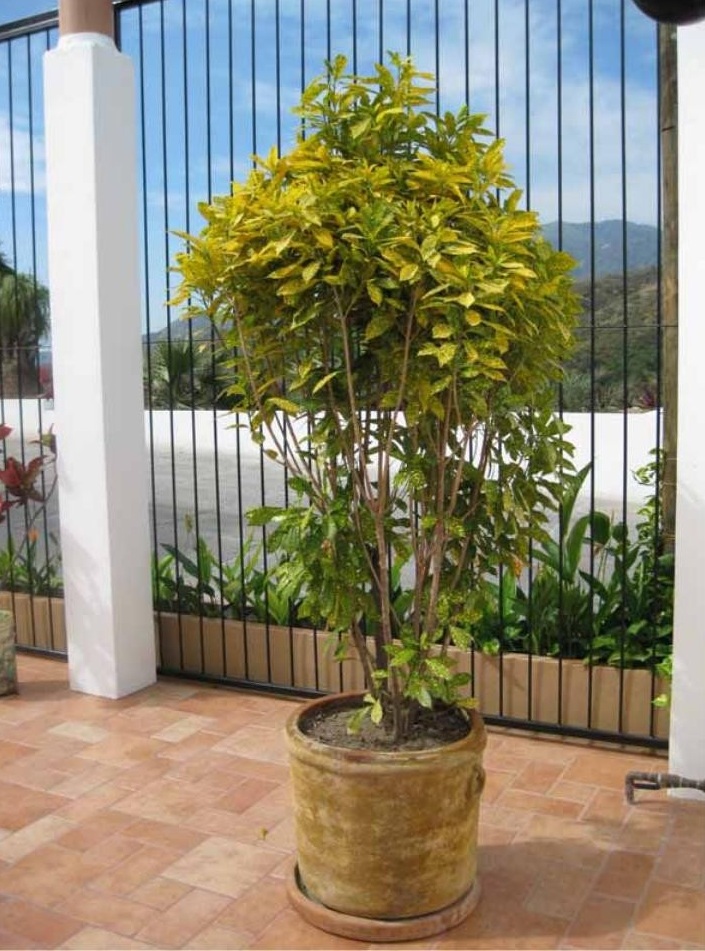
You must be logged in to post a comment.